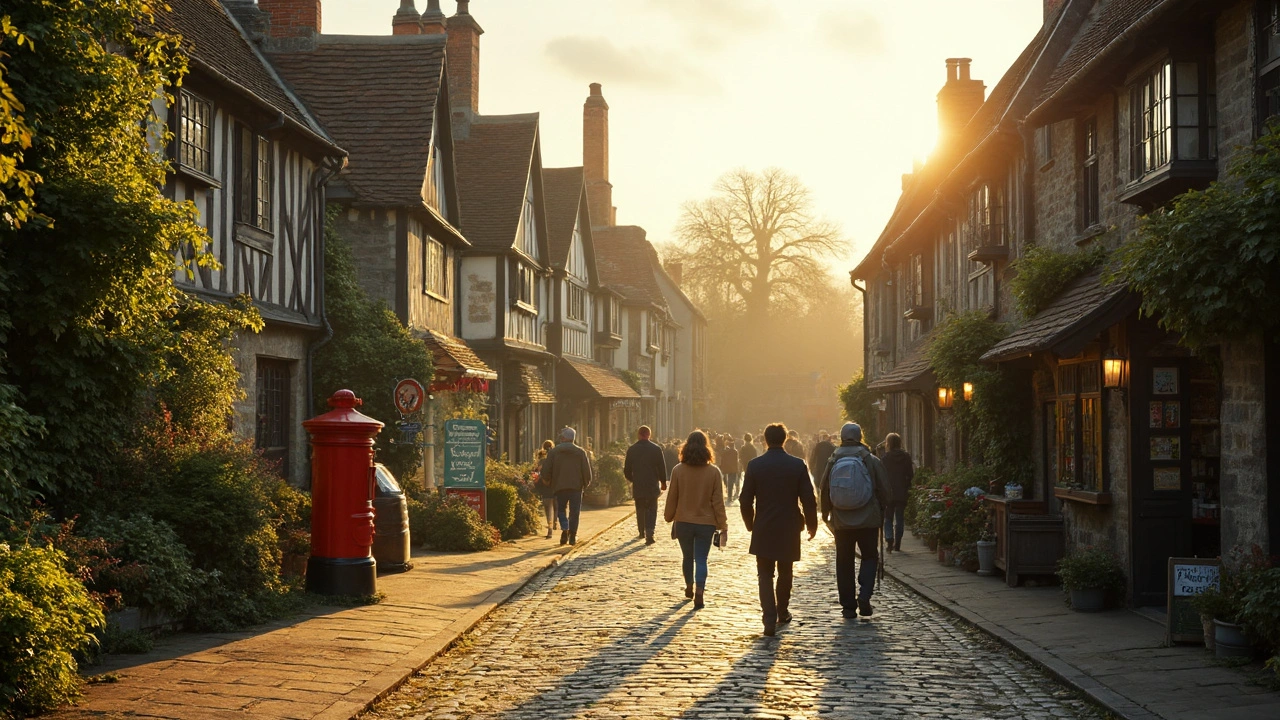
People think England is all rolling hills and afternoon tea, but the country’s real roots are buried deep in its oldest cities. Ask around, and Colchester usually pops up as the granddad of the lot—older than London itself. Colchester’s got the Roman walls, the ruins, and even its own legend about being Britain’s first capital. But there’s a twist: other spots, like Canterbury, argue they could wear the crown.
The race to be called England’s oldest city isn’t just trivia. It shows how history gets built on stories, ruins, and official titles. Locals in Colchester are proud—there’s even a Roman circus under a modern housing estate. Tourists who want a break from London’s noise can hop on a train and stand where soldiers, traders, and ordinary people walked back when the Romans ruled the island. So, if you crave history that you can actually touch, knowing the real ‘oldest city’ means more than just winning a pub quiz.
- The Big Contenders: Who Claims the Title?
- What Makes a City 'Old' Anyway?
- Colchester: England’s Ancient Capital
- Tips for Exploring Ancient Cities Today
The Big Contenders: Who Claims the Title?
Ask ten Brits about the oldest city in England, and you'll probably get at least three different answers. Let’s put the rumor mill to rest and call out the front-runners: Colchester, Canterbury, and a couple of wildcards like London and St Albans.
Colchester tends to grab the spotlight. It’s got solid bragging rights after being called “Camulodunum” by the Romans and serving as their very first capital in Britain, starting around AD 49. The city has a record of continuous settlement dating back even before the Romans, with signs of life from the Celtic tribe called the Trinovantes. Colchester’s Roman walls are some of the best-preserved in the country, and you’ll still see parts snaking right through the modern city.
Next up is Canterbury. Plenty know it for the huge cathedral and as a magnet for pilgrims since medieval times, but its roots stretch even further. Archaeologists found settlements there from prehistoric times—plus it scored Roman town status in the first century. Some historians point to Canterbury’s uninterrupted city life stretching well before Roman arrival.
You’ll hear folks in London try to stake a claim, but London sprang up a little after Colchester, built on fresh Roman ambition rather than sleepy old settlements. And don’t forget about St Albans (the Roman Verulamium), which also goes way back and played a big role during Roman Britain.
| City | Claim to Fame | First Recorded Settlement |
|---|---|---|
| Colchester | First Roman capital; oldest recorded town | Before AD 43 (Celtic), AD 49 (Roman) |
| Canterbury | Medieval pilgrimage hub; Roman settlement | Pre-Roman, 1st century AD (Roman) |
| London | Modern capital; major Roman city | AD 47 (Roman) |
| St Albans | Roman town (Verulamium) | Pre-Roman, AD 50 (Roman) |
So, why all the debate? It comes down to what you count—a place with ancient homes, a city with a Roman charter, or just whoever had the earliest mention in dusty history books. But if you’re gunning for the current champion, Colchester usually stands tall for sheer documented age and Roman street cred. If you want to win that pub argument or plan a proper ancient cities UK tour, remember these names—they pop up in any real debate on the oldest city in England.
What Makes a City 'Old' Anyway?
Calling a place the oldest city in England sounds simple, but it’s a lot more complicated than just tracking down the oldest bricks. There’s no official rulebook that settles things. Some cities have been around since before the Romans; others only got their "city" status much later from a royal charter—even if people lived there for ages before that.
So, what actually counts? Historians look at a mix of factors:
- Continuous Settlement: Has the city been lived in, without big gaps, since it was founded? Gaps of a couple of hundred years can knock a contender out of the running.
- Evidence of Urban Life: This means proper remains—walls, streets, market squares, maybe even coins or writing. It’s not enough that a few folks camped there; the place had to function like a real city.
- Official Recognition: The word “city” itself is tricky in England. The government only started formally handing out city status in 1540. Before that, it was more about vibe and history than paperwork.
Take a look at how different places stack up by these measures:
| City | Date of Earliest Records | Roman Remains? | Unbroken Settlement? |
|---|---|---|---|
| Colchester | Before 50 AD | Yes | Yes |
| Canterbury | Before 1st century AD | Yes | Yes |
| London | Early 1st century AD | Yes | Yes |
Don’t forget: archaeology is always finding new stuff. A dig in Colchester uncovered the UK’s only-known Roman chariot racing track right under a housing estate. Who knows what’s next? This never-ending hunt for proof is what keeps the “oldest city” debate spicy. And if you’re planning to visit, knowing these details makes exploring places like Colchester way more fun. You’re walking through 2,000 years of actual history, not just old stones.

Colchester: England’s Ancient Capital
If you’re looking for the oldest city in England, Colchester has the strongest case. We're talking serious age here—people have lived in the area for over 2,000 years. The Romans called it Camulodunum, and it was the first city in Britain to be given the official 'city' title by the Romans in AD 49. That Roman city didn’t just show up out of nowhere either; before the legions arrived, it was a major Celtic stronghold and even the capital for a local tribe called the Trinovantes.
Colchester isn’t just coasting on legends. Roman walls still circle the town, some of the oldest and best-preserved in the country. The massive gate near Balkerne Hill? Original Roman work. There’s the Roman Circus too—not a clown in sight, but an ancient chariot-racing track, the only one ever found in Britain. And if you like museums, the Colchester Castle museum sits on the foundations of a Roman temple. Inside, you’ll spot everything from Roman glass to coins and military gear that look straight out of a ‘swords and sandals’ film.
Check this—archaeologists found more Roman pottery and artifacts in Colchester than just about anywhere else in the UK. Here’s a quick breakdown of what’s still visible if you wander the city:
- Sections of Roman town wall (some 2,000 years old!)
- The Balkerne Gate—biggest surviving Roman gateway in Britain
- Roman Circus remains and interpretive centre
- The ancient foundations inside Colchester Castle
- Visible mosaic floors at sites like Castle Park
If you want actual numbers, experts believe Colchester’s wall was built around 65-80 AD and still stands about 2,000 meters long in sections. That makes it even older than London’s Roman wall by about 30 years.
So, if your goal is to set foot in the true ancient city of England, Colchester has physical proof right under your feet—no guesswork needed.
Tips for Exploring Ancient Cities Today
Want to actually walk through the layers of time? It helps to have a plan, especially if you’re aiming to get the most out of places like Colchester, Canterbury, or any other ancient spot. These aren’t just random old ruins—they’re some of the best-preserved bits of Roman Britain, and they’re set up to make exploring pretty easy if you know what to look for.
- Go beyond the obvious: Sure, Colchester Castle is front and center, but the real gold is in places like the Roman Circus (the only one in Britain) and the Balkerne Gate, billed as the oldest surviving Roman gateway in the country.
- Check for guided tours: Local tours often get you into areas you’d totally miss by yourself—think hidden cellars, Roman walls tucked behind shops, and rooftops with killer views of the city. Guided walks in Colchester are known for packing in little-known facts and showing where Roman roads still sit under current streets.
- Hit the museums first: Colchester's Castle Museum has original Roman foundations you can touch—and seeing the bones and mosaics before you go outside makes the real town way more interesting.
- Plan for street markets and local food: Outdoor markets sometimes line up right next to historic walls or ancient churches. Stop for street food and enjoy the mix of old and new.
If you’re a numbers person, check this out:
| Site | Founded | Main Attractions | Annual Visitors (approx) |
|---|---|---|---|
| Colchester | 43 AD (Roman) | Castle, Roman Circus, Town Walls | 5 million |
| Canterbury | 1st century AD | Cathedral, Roman Museum, City Walls | 7 million |
| London | 47 AD (Roman) | Tower of London, Roman Amphitheatre | 21 million |
Before you head out, check local websites for any special events—Colchester loves reenactments and pop-up history days, and those can totally change your visit. Wear comfy shoes, bring a phone for snapping photos of those ancient cities, and if you’re a fan of ghost stories, ask around after dark—you’d be surprised where old city legends pop up.